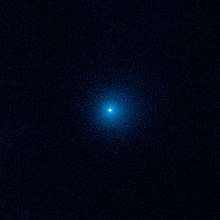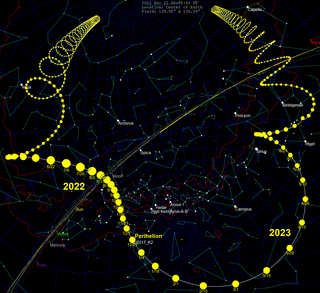C/2017 K2
C/2017 K2 (PANSTARRS) is an Oort cloud comet with a hyperbolic orbit, discovered in May 2017 at a distance beyond the orbit of Saturn when it was 16 AU (2.4 billion km) from the Sun. Precovery images from 2013 were located by July.[7] It has been in the constellation of Draco since July 2007. As of April 2020, the 3-sigma uncertainty in the current distance of the comet from the Sun is ±10,000 km. The comet is record breaking because it is already becoming active at such a distance, only comet Hale Bopp produced such a show from that distance and having a similar nucleus. However this comet will not be as visible as Hale Bopp was in 1997, although it will reach naked eye visibility on its perihelion. Astronomers have never seen an active inbound comet this far out, where sunlight is 1/225th it's brightness as seen from Earth. Temperatures, correspondingly, are at a minus 440 degrees Fahrenheit (-262 °C). Even at such cold temperatures, a mix of ancient ices on the surface of oxygen, nitrogen, carbon dioxide and carbon monoxide is beginning to sublimate and shed as dust. This material expands into a vast 80,000 mile-wide or 130,000 Km wide halo of dust, called a coma, enveloping the solid, large nucleus.[8]
 June 2017 by Hubble's Wide Field Camera 3[1] | |
| Discovery | |
|---|---|
| Discovery date | 21 May 2017[2] |
| Orbital characteristics [ A] | |
| Epoch | 2022-12-07 (2459920.5) |
| Observation arc | 7.03 years |
| Orbit type | Oort cloud |
| Aphelion | ~56000 AU (inbound)[lower-alpha 1] |
| Perihelion | 1.7969 AU[3] |
| Eccentricity | 1.0008 |
| Orbital period | Millions of years inbound[lower-alpha 1] ~26,000 years (outbound) |
| Inclination | 87.563° |
| Node | 88.26730 |
| Earth MOID | 1.10 AU (165 million km) |
| Jupiter MOID | 1.29 AU |
| Dimensions | Rn between 14 km (8.7 mi) and 80 km (50 mi)[4] maximum Dn ~18 km (11 mi)[5] |
| Next perihelion | 19 December 2022[3][6][lower-alpha 2] |
Research with the Canada–France–Hawaii Telescope (CFHT) infers the comet nucleus to have a radius between 14 and 80 km, so there is a chance the nucleus could be as large as C/1995 O1 (Hale-Bopp)".[4] However, research with the Hubble Space Telescope (HST) estimates the nucleus to have a circular equivalent diameter of less than 18 km.[5]
Around 6 July 2022, the comet will cross the celestial equator, and then around 14 July 2022, it will pass 1.8 AU (270 million km) from Earth and shining at 7.0 magnitude at that time.[9][6] It will reach perihelion around 19 December 2022, close to the orbit of Mars, and will possibly be visible to naked eye at 6.0 magnitude.[3][6][lower-alpha 2]

Path of C/2017 K2 in the sky
JPL Horizons using an epoch 1950 orbit solution models that C/2017 K2 took millions of years to come from the Oort cloud at a distance of roughly 56,000 AU (0.89 ly).[lower-alpha 1]
References
- "Distant active comet C/2017 K2". www.spacetelescope.org. Retrieved 3 October 2017.
- "MPEC 2017-K35 : COMET C/2017 K2 (PANSTARRS)". IAU Minor Planet Center. 2017-05-24. Retrieved 2017-10-21. (CK17K020) (3 day obs arc)
- "C/2017 K2 (PANSTARRS) Orbit". Minor Planet Center. Archived from the original on 2017-11-13. Retrieved 2017-11-13.
- Meech, Karen (2017). "CO-Driven Activity in Comet C/2017 K2 (PANSTARRS)". The Astrophysical Journal Letters. 849 (1): L8. arXiv:1710.03876. Bibcode:2017ApJ...849L...8M. doi:10.3847/2041-8213/aa921f.
- Jewitt, David (2017). "A Comet Active Beyond the Crystallization Zone". The Astrophysical Journal. 847 (2): L19. arXiv:1709.10079. Bibcode:2017ApJ...847L..19J. doi:10.3847/2041-8213/aa88b4.
- Seiichi Yoshida. "C/2017 K2 ( PanSTARRS )". Seiichi Yoshida's Comet Catalog. Retrieved 2020-06-02.
- "MPEC 2017-N26 : COMET C/2017 K2 (PANSTARRS)". IAU Minor Planet Center. 2017-07-01. Retrieved 2017-10-21.
- Ghosh, Trinankur (21 March 2020). 2017 K2 "Farthest active inbound comet yet/space/Earthsky" Check
|url=value (help). Earthsky. Retrieved 20 March 2020. - Hubble Spots Farthest-Ever Incoming Active Comet September 29, 2017
Notes
- Computed with JPL Horizons using a barycentric solution. Ephemeris Type: Orbital Elements / Center: @0 (To be outside planetary region, inbound epoch 1950 and outbound epoch 2050)
- Perihelion passage: Given perihelion is still 5 years away, an epoch of 2022 gives a more accurate perihelion date that properly accounts for planetary perturbations. An epoch 2017 unperturbed two-body solution (Sun+comet) gives a date of 2022-Dec-21. Integrating the orbit with JPL Horizons which accounts for planetary perturbations gives a date of 2022-Dec-19. The Minor Planet Center's Epoch Dec 2022 solution also gives a date of 2022 Dec. 19
External links
- A Comet Active Beyond the Crystallization Zone
- MPEC 2017-K90 : COMET C/2017 K2 (PANSTARRS)
- NASA's Hubble Observes the Farthest Active Inbound Comet Yet Seen
- Note on the dynamical evolution of C/2017 K2 PANSTARRS (arXiv 2018)